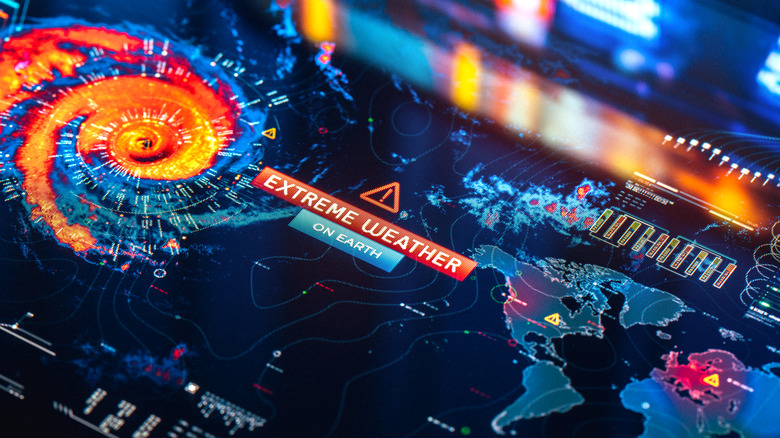Here's How AI Will Change The Future Of Weather Forecasting
Not knowing what the weather is going to do has long been the bane of mankind's existence. Whether it will snow on a school day, rain during a camping trip, or be too hot to go to the beach are often things we can't predict with any real accuracy until they come to pass. That's just day-to-day forecasting, as opposed to extreme weather like hurricanes and tornadoes. Meteorologists, of course, do their best. However, more often than not, what they expect to happen can be at odds with the reality of the weather situation.
As with anything, since technology has advanced, so too has the ability for scientists to nail down what Mother Nature will do with more accuracy. But artificial intelligence, it seems, is taking weather forecasting to a new level. Not only does it allow for more exact predictions, but it's also going to expedite the process, making for much more advanced warning systems. Here's how.
How weather prediction works now
Current forecasting models are calculated through the use of general circulation models. These climate models, according to the National Oceanic and Atmospheric Administration, "use mathematical equations to characterize how energy and matter interact in different parts of the ocean, atmosphere, land. Building and running a climate model is a complex process of identifying and quantifying Earth system processes, representing them with mathematical equations, setting variables to represent initial conditions and subsequent changes in climate forcing, and repeatedly solving the equations using powerful supercomputers."
The problem is that this system, while useful for compiling data, falls short in the areas of "simulating atmospheric variables quickly at very short time scales, or accurately at long time scales," notes one UCLA study.
As such, those in the tech segment are investing heavily in exploring artificial intelligence options, especially as climate change ramps up. As more extreme weather patterns emerge, so too does the need for faster, more accurate prediction of possible destruction.
What AI can do to help
The European Centre for Medium-Range Weather Forecasts is embracing AI modeling, according to an article from Science. Moreover, tech giant Google has invested in GraphCast — an AI model that deploys "deep learning" rather than mathematical problem-solving to generate forecasts. Using a mix of observed weather phenomena, historical weather predictions, and atmospheric "snapshots," these AI models are providing faster, more accurate predictions. One of the GraphCast paper writers, Rémi Lam, notes, "It is fast, accurate, and useful."
For now, these models rely on what science calls "reanalysis data," which may be flawed because they rely on old (potentially unreliable) forecasting models. To improve, AI models will need to rely on weather data collected from government agencies instead. Though the tech is evolving fast, for now, it is used more in tandem with current systems for weather prediction.
Moreover, one concern, as noted by Science, is that while the prediction of extreme weather is important in a world plagued by climate change, using energy-deficient computers to generate this data could also be doing potential harm.


